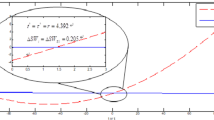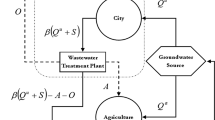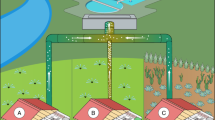Abstract
Urban wastewater and agriculture activities are the main sources of urban water pollution and of eutrophying nutrients in many water ecosystems. Several EU directives have been adopted and affect the control of urban water pollution. The EU legislation requires the achievement of good ecological and chemical status in all water. This paper focuses on the use of economic instruments as a priority in the context of implementation. Our analysis only considers public wastewater utilities facing demand and capacity shocks. The proposed mechanism constitutes efficient means of moving towards sustainability by promoting full-cost pricing and considering external costs from wastewater services. Environmental damage associated with urban water pollution are internalized. The model also explicitly considers the investment needed to set-up wastewater system facilities. Our results indicate that savings in capacity could be achieved by adopting the proposed incentive-based mechanism that characterizes the optimal capacity selection rule.
Similar content being viewed by others
Notes
The United Nations designated 2008 as the Year of Sanitation due to World Health Organization estimates of 80% of all sickness in the world being attributed to unsafe water and sanitation (UN Wire, 17 August 2007).
Council Directive 98/83/EC on water intended for human consumption.
The estimated cost for complying with the provisions of the directive in the different EU 15 member states is about 130 billion euros [33].
On 24 June 2004, the European Court of Justice condemned Greece for not taking the necessary measures for the installation of a collecting system for urban wastewater.
For example, the Czech government estimated the figure for achieving EU water standards at US $2.5 billion to be invested in the water sector by 2010, for 99 new treatment plants, 21 new sewerage systems, and 141 upgrades.
Agglomeration usually refers to cities or towns. The generated load of agglomerations can be used as a parameter to calculate the capacity of treatment plants in the planning stage. The plant is dimensioned based on this load, after including an additional multiplying factor in the calculation (i.e., to take account of seasonal variations and a possible extension of the agglomeration).
Population equivalent (P.E.) is the standard unit for calculating the organic biodegradable pollution load and refers to the organic pollution in wastewater.
Transition periods must not exceeds 2015 and in one case, Romania, smaller agglomerations have to comply by 2019.
The term “water services” has been introduced in the WFD, Article 2, point 38. The term was further specified in the WATECO guidance document since this term is of importance for taking into account the principle of recovery of the costs of water services including environmental and resources costs.
As stated in the directive, pricing is a “basic” measure (Art. 11-3b).
I thank the Editor-in-Chief and the Associate Editor of this journal for bringing different works to my attention.
Only the few recent contributions related to wastewater services are reviewed.
Sometimes, the direct use of water from natural sources by some industries represents in some case roughly 75% of total water consumption [25].
We assume that branch pipe includes a wastewater meter.
Also called the single-crossing condition or the sorting condition because it may allow us to sort through the different types of the consumer [23].
We suppose that the second-order conditions are verified.
Commercial and industrial water users have a wide range of technology, input and project choices that affect their water-born waste load. Facing an increase in sewage charges, industrial and commercial users often find that the public sewer system is no longer the most cost-effective means of sewage disposal. Instead, recycling and reuse emerge as more economical options, and industries choose to switch to more self-treatment and effluent reuse. Also, facing more stringent regulation, several industries, including chemical, pulp and paper, textiles and metallurgy industries, have changed production processes and have made significant progress in reducing their waste services demands.
I thank a referee for pointing this out.
Wastewater utilities in different regions in the United States charge outside-city users higher wastewater rates by about 15% than inside-city users. It depends on how these regions are committed to environmental preservation and health.
If the public utility buys extra capacity off neighboring ones, then it can sell any when other utilities have excess demand. This implies that the structure of the model must be modified. In the following φ is assumed to represent the marginal social cost of overflows. I thank a referee for pointing this out.
For both, the assumed fixed proportional technology and the penalty technology to be an economical option, φ should be in the range defined above.
In the following, we consider that the second-order conditions associated with the optimization problems, both locally and globally, are verified.
The term \(\left( 1-\mathcal{F}_{\tau }\left( \widetilde{\omega }_{\tau }\right) \right) \) can be considered, for example, as the probability that severe weather conditions occur or peak periods take place following a common shock.
It should be noted that computations are sometimes cumbersome. Derivations are relegated to the Appendix. While the calculations are messy, they are not difficult.
λ can also be viewed as the shadow price of public funds [23].
Recall that φ is the social cost of overflows.
References
Armstrong, M., Cowan, S., & Vickers, J. (1994). Regulatory reform: Economic analysis and British experience. Cambridge: MIT.
Bartoszczuk, P., & Nakamori, Y. (2004). Modeling sustainable water prices (Chapter 10). Cheltenham: Edward Elgar.
Boiteux, M. (1949). La tarification des demandes de pointes: Application de la théorie de la vente au coût marginal. La Revue Générale de l’Electricité, 58(8), 321–340.
Boiteux, M. (1954). Sur la gestion des monopoles publics astreints à l’équilibre budgétaire. Econometrica, 24(1), 22–40.
Chao, H. P. (1983). Peak load pricing and capacity planning with demand and supply uncertainty. Bell Journal of Economics and Management Science, 14, 179–190.
Cowan, S. (1993). Regulation of several market failures: The water industry in England and Wales. Oxford Review of Economic Policy, 9(4), 14–23.
Dandy, G. C., McBean, E. A., & Hutchinson, B. G. (1984). A model for constrained optimum water pricing and capacity expansion. Water Resources Research, 20(5), 511–520.
Dandy, G. C., McBean, E. A., & Hutchinson, B. G. (1985). Pricing and expansion of a water supply system. The Journal of Water Resources Planning and Management, III(1), 24–42.
Elnaboulsi, J. C. (1999). A model for constrained Peak-load water and wastewater pricing and capacity planning. Canadian Water Resources Journal, 24(2), 87–96.
EC (1991). Council of the European Communities. Directive concerning urban wastewater treatment (91/271/EEC). Official Journal, L135, 40–52.
EC (1991). Council of the European Communities. Directive concerning protection of water against pollution by nitrates from agriculture (91/676/EEC). Official Journal, L375, 1.
EC (1991). Council of the European Communities. Directive concerning the placing of plant protection products on the market (91/414/EEC). Official Journal, L230, 19 August 1991.
EC (1992). Council of the European Communities. Directive on the conservation of natural habitats and of wild fauna and flora (92/43/EEC). Official Journal, L206, 7–50.
EC (1996). Council of the European Communities. Directive on integrated pollution prevention and control (96/61/EC). Official Journal, L257, 10 October 1996.
European Parliament (2000). European Union Water Framework Directive 2000 /60/EC. 23 October 2000, published in December. Official Journal, L 327, 22/12/2000.
Fernandez, L. (1997). Estimating of wastewater treatment objectives through maximum entropy. Journal of Environmental Economics and Management, 32, 293–308.
Griffin, R. C. (2006). Water resource economics: The analysis of scarcity, policies, and projects. Cambridge: MIT.
Haurie, A., & Krawczyk, J. B. (1997). Optimal charges on river effluent from lumped and distributed sources. Environmental Modeling and Assessment, 2, 177–189.
Helm, D. (1991). Privatization and environmental regulation in the water and electricity industries. Royal Bank of Scotland Review, 172, 30–37.
Helm, D. (1993). Market mechanisms and the water environment: Are they practicable? In A. Gilland (Ed.), Efficiency and effectiveness in the modern water business. London: Centre for the Study of Regulated Industries, Public Finance Foundation.
Krawczyk, J. B., Pourtallier, O., & Tidball, M. (1998). A steady-state satisfactory solution to an environmental game with piecewise defined payoffs. Natural Resource Modeling, 11, 301–329.
Krawczyk, J. B., & Zaccour, G. (1999). Management of pollution from decentralised agents by the local government. International Journal of Environment and Pollution, 12, 343–357.
Laffont, J.-J., & Tirole, J. (1993). A theory of incentives in procurement and regulation. Cambridge: MIT.
Laukkanen, M., & Huhtala, A. (2008). Optimal management of a eutrophied coastal ecosystem: Balancing agriculture and municipal abatement measures. Environmental and Resource Economics, 39, 139–159.
OECD (2009). Managing water for all: An OECD perspective on pricing and financing. Paris: OECD.
Panzar, J. C., & Sibley, D. S. (1978). Public utility pricing under risk: The case of self-rationing. The American Economic Review, 68(5), 888–895.
Pargal, S., & Wheeler, D. (1996). Informal regulation of industrial pollution in developing countries: Evidence from Indonesia. Journal of Political Economy, 104(6), 1314–1327.
Roberts, D., & Spence, M. (1976). Effluent charges and licenses under uncertainty. Journal of Public Economics, 5, 193–208.
Shah, S. A. (2005). Optimal management of durable pollution. Journal of Economic Dynamics and Control, 29, 1121–1164.
Spence, M. (1977). Non linear prices and welfare. The Journal of Public Economics, 8(1), 1–18.
Willig, R. D. (1976). Consumer’s surplus without apology. The American Economic Review, 66(4), 589–597.
Wilson, R. B. (1993). Nonlinear pricing. Oxford: Oxford University Press.
Zabel, T., Milne, I., & Mckay, G. (2001). Approaches adopted by the European Union and selected member states for the control of urban pollution. Urban Water, 3, 25–32.
Acknowledgements
For useful comments and suggestions that improved the presentation, I especially thank the Editor-in-Chief and the Associate Editor of this journal. I also gratefully acknowledge the extensive comments on the paper received from two anonymous referees that have helped me to improve it. I alone, however, am responsible for any error or omission. Financial support from the Portuguese Ministry of Science and Technology is gratefully acknowledged.
Author information
Authors and Affiliations
Corresponding author
Appendix
Appendix
The Kuhn–Tucker necessary conditions for maximizing the program in Eq. 22 with respect to p, and k will be
Combining the last two equations, and taking into account the break-even constraint, the optimal condition for a maximum k is giving by
Concerning p, we have
Combining the last two equations, and taking into account the break-even constraint, the optimal condition for a maximum p is giving by the following relation
Equations 36 and 39 can be arranged to give Eqs. 26 and 27 in the text.
Rights and permissions
About this article
Cite this article
Elnaboulsi, J.C. An Efficient Pollution Control Instrument: The Case of Urban Wastewater Pollution. Environ Model Assess 16, 343–358 (2011). https://doi.org/10.1007/s10666-011-9261-7
Received:
Accepted:
Published:
Issue Date:
DOI: https://doi.org/10.1007/s10666-011-9261-7




